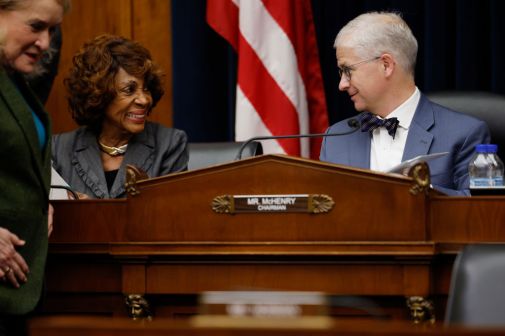AI talent role, releasing code, deadline extension among additions in OMB memo

Additions and edits to the Office of Management and Budget’s final memo on AI governance create additional public disclosure requirements, provide more compliance time to federal agencies, and establish a new role for talent.
The policy, released Thursday, corresponds with President Joe Biden’s October executive order on AI and establishes a framework for federal agency use and management of the technology. Among the requirements, agencies must now vet their AI uses for risks, expand what they share in their annual AI use case inventories, and select a chief AI officer.
While the final version largely tracks with the draft version that OMB published for public comment in November, there were some notable changes. Here are six of the most interesting alterations and additions to the policy:
1. Added compliance time: The new policy changes the deadline for agencies to be in compliance with risk management practices from Aug. 1 to Dec. 1, giving agencies four more months than the draft version. The requirement states that agencies must implement risk management practices or stop using safety- or rights-impacting AI tools until the agency is in compliance.
In a document published Thursday responding to comments on the draft policy, OMB said it received feedback that the August deadline was “too aggressive” and that timeline didn’t account for action OMB is expected to take later this year on AI acquisition.
2. Sharing code, data: The final memo adds an entirely new section requiring agencies to share custom-developed AI code model information on an ongoing basis. Agencies must “release and maintain that code as open source software on a public repository” under the memo, unless sharing it would pose certain risks or it’s restricted by law, regulation, or contract.
Additionally, the memo states that agencies must share and release data used to test AI if it’s considered a “data asset” under the Open, Public, Electronic and Necessary (OPEN) Government Data Act, a federal law that requires such information to be published in a machine-readable format.
Agencies are required to share whatever information possible, even if a portion of the information can’t be released publicly. The policy further states that agencies should, where they’re able, share resources that can’t be released without restrictions through federally operated means that allow controlled access, like the National AI Research Resource (NAIRR).
3. AI Talent Lead: The policy also states agencies should designate an “AI Talent Lead,” which didn’t appear in the draft. That official, “for at least the duration of the AI Talent Task Force, will be accountable for reporting to agency leadership, tracking AI hiring across the agency, and providing data to [the Office of Personnel Management] and OMB on hiring needs and progress,” the memo says.
The task force, which was established under Biden’s AI executive order, will provide that official with “engagement opportunities to enhance their AI hiring practices and to drive impact through collaboration across agencies.” The memo also stipulates that agencies must follow hiring practices in OPM’s forthcoming AI and Tech Hiring Playbook.
Biden’s order placed an emphasis on AI hiring in the federal government, and so far OPM has authorized direct-hire authority for AI roles and outlined incentives for attracting and retaining AI talent.
4. Aggregate metrics: Agencies and the Department of Defense will both have to “report and release aggregate metrics” for AI uses that aren’t included in their public inventory of use cases under the new memo. The draft version included only the DOD in that requirement, but the version released Thursday added federal agencies.
Those disclosures, which will be annual, will provide information about how many of the uses are rights- and safety-impacting and their compliance with the standards for those kinds of uses outlined in the memo.
The use case inventories, which were established by a Trump-era executive order and later enshrined into federal statute, have so far lacked consistency across agencies. The memo and corresponding draft guidance for the 2024 inventories seeks to enhance and expand those reporting requirements.
5. Safety, rights determinations: The memo also added a new requirement that agencies have to validate the determinations and waivers that CAIOs make on safety- and rights-impacting use cases, and publish a summary of those decisions on an annual basis.
Under the policy, CAIOs can determine that an AI application presumed to be safety- or rights-impacting — which includes a wide array of uses such as election security and conducting biometric identification — doesn’t match the memo’s definitions for what should be considered safety- or rights-impacting. CAIOs may also waive certain requirements for those uses.
While the draft stipulated that agencies should report lists of rights- and safety-impacting uses to OMB, the final memo instead requires the annual validation of those determinations and waivers and public summaries.
In its response to comments, OMB said it made the update to address concerns from some commenters that CAIOs “would hold too much discretion to waive the applicability of risk management requirements to particular AI uses cases.”
6. Procurement considerations: Three procurement recommendations related to test data, biometric identification, and sustainability were also added to the final memo.
On testing data, OMB recommends agencies ensure developers and vendors aren’t using test data that an agency might employ to evaluate an AI system to train that system. For biometrics, the memo also encourages agencies to assess risks and request documentation on accuracy when procuring AI systems that use identifiers such as faces and fingerprints.
And finally on sustainability, the memo includes a recommendation that agencies consider the environmental impact of “computationally intensive” AI systems. “This should include considering the carbon emissions and resource consumption from supporting data centers,” the memo said. That addition was a response to commenters who wanted the memo to expand risk assessment requirements to include environmental considerations, according to OMB.






